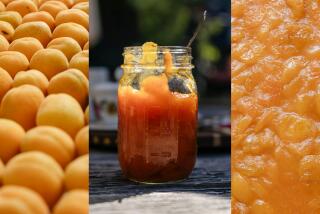Taking the Mystery Out of Exotic Fruit
- Share via
Cherimoya, passion fruit and pepino--three exotic fruit now often found in supermarket produce sections--have several things in common: They’re native to South America but are now grown in New Zealand and California, and they’re better raw than cooked. They’re also a cinch to prepare, and are great conversation starters.
Cherimoya are available November through May, pepino in late winter and spring and passion fruit throughout the year.
CHERIMOYA: This fruit is also called custard apple because of its silky smooth, custard-like flesh. The slightly pear- or heart-shaped cherimoya has a light-green or yellow-green skin covered with small lobes or facets. Some varieties are speckled with tan.
The cream-colored flesh is low in acid, sweet and juicy. It is generously studded with large, inedible black seeds.
There are a number of varieties of cherimoya with slightly different flavors. Some experts compare the taste to a subtle blend of papaya, pineapple and banana. Others say it is suggestive of strawberries, raspberries, pears, mango or vanilla custard.
The fruit is harvested while still very firm and must be handled gently to avoid damage. When choosing cherimoya, you can accept small surface scars but avoid fruit with large dark areas. Ripen at room temperature until fruit gives to gentle pressure.
Cherimoya is best served chilled. Refrigerate ripe fruit in a paper or plastic bag and store no longer than a couple of days.
To serve, halve or quarter the fruit, cut away the central fiber if it’s still hard, sprinkle with citrus juice and eat with a spoon. Or peel, thinly slice, remove the seeds and combine with other fruit for a salad.
Cherimoya may also be put through a sieve and made into a sauce. Add a small amount of whipping cream and, if desired, a dash of nutmeg and serve over delicate cakes, poached fruit or crepes. The same mixture may be used as the base for ice cream or souffles.
PASSION FRUIT:
Christian missionaries named the fruit for the Passion of Christ after they saw symbols of the crucifixion in the plant’s flower. The fruit is egg-shaped, two to three inches long and has a thick, hard, purplish-brown shell.
Inside is a gelatinous yellow-orange pulp laced with many soft edible seeds. It has a sweet-tart exotic flavor and aroma suggestive of jasmine, honey and lemon.
Passion fruit is ripe when the dark-purple shells are shriveled, wrinkled or even a little moldy. It should yield to gentle pressure but still be firm. If it is still smooth-skinned when purchased, ripen the fruit at room temperature until shriveled.
Store ripened fruit in the refrigerator for a few days or pop into a plastic bag and freeze for up to six months. You can also package and freeze just the pulp and seeds.
The simplest way to eat passion fruit is to cut it in half and scoop out the pulp and seeds with a spoon. Add a splash of lime juice or pour on a little half and half or whipping cream, if desired.
The pulp may be put through a sieve to remove the seeds and used for a sauce, pastry filling or beverage flavoring. It also can be used as the base ingredient for ices, ice cream, mousses, souffles and jelly.
PEPINO:
The word means cucumber in Spanish, but it’s also the name of a small, teardrop-shaped melon that tastes like a cross between cantaloupe and honeydew.
The exterior skin has a golden background marked with purple and greenish-yellow stripes. The pulp inside is pale yellow-green to yellow-orange with a melon-like texture.
Most pepinos are underripe when they arrive in the market. Ripen the melons at room temperature, uncovered and away from direct sunlight, turning them occasionally.
The melon is ready to eat when it feels like a partly ripe plum. Refrigerate ripe fruit up to three days.
Like most melons, pepinos are delicious served for breakfast with a sprinkling of lemon or lime juice. Chunks of the melon also make good additions to fruit, spinach or seafood salads.
Although best served raw, slices of pepino may be sauteed and served as an accompaniment to meats. The skin and seeds are edible, but most people prefer to eat only the pulp.
captions:


